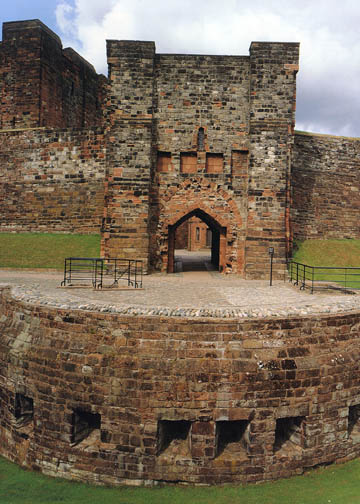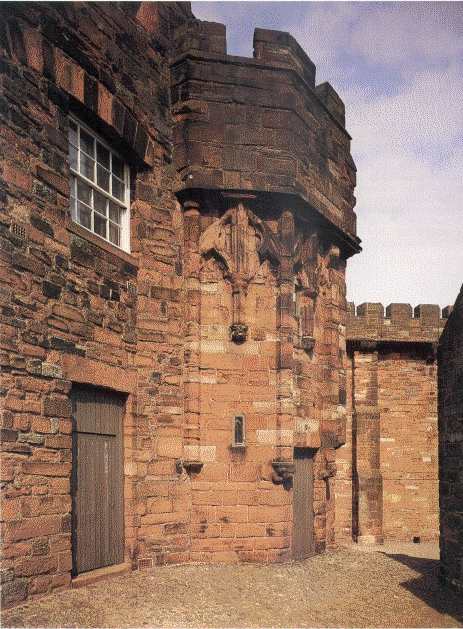Carlisle Castle
Mary, Queen of Scots Home Page
 Carlisle Castle started out as a Roman garrison and fort from
the first to the fourth centuries. This was still partly standing in 685, when
St Cuthbert visited Carlisle. In 1092, William II (Rufus) went north to drive
out Dolfin (son of Earl Gospatrick of Northumbria), and erected a castle. This
may have been no more than a single rampart, but thirty years later, Carlisle's
defences were refashioned in stone by Henry I. He ordered the works to be
fortified with a castle and towers, and within a decade, the city walls were
built and a beginning made on the stone keep. Both were completed by
Kind David I during the long Scottish occupation of the northern counties. David was
succeeded by Malcolm IV but in 1157, Carlisle and its region were returned to
England. Henry II contributed to the fortress with a stone outer curtain,
pierced by a new southern gate. After an aborted attempt by William the Lion to
seize the castle, the citizens of Carlisle opened the gates to the rebels
Scottish allies in 1216 in protest against their unpopular King John. Alexander II's assault on the castle resulted in the destruction of the south curtain ,
followed by the inner gate and the keep.
Carlisle Castle started out as a Roman garrison and fort from
the first to the fourth centuries. This was still partly standing in 685, when
St Cuthbert visited Carlisle. In 1092, William II (Rufus) went north to drive
out Dolfin (son of Earl Gospatrick of Northumbria), and erected a castle. This
may have been no more than a single rampart, but thirty years later, Carlisle's
defences were refashioned in stone by Henry I. He ordered the works to be
fortified with a castle and towers, and within a decade, the city walls were
built and a beginning made on the stone keep. Both were completed by
Kind David I during the long Scottish occupation of the northern counties. David was
succeeded by Malcolm IV but in 1157, Carlisle and its region were returned to
England. Henry II contributed to the fortress with a stone outer curtain,
pierced by a new southern gate. After an aborted attempt by William the Lion to
seize the castle, the citizens of Carlisle opened the gates to the rebels
Scottish allies in 1216 in protest against their unpopular King John. Alexander II's assault on the castle resulted in the destruction of the south curtain ,
followed by the inner gate and the keep.
The peace which ensued after 1217 was broken by the Wars of
Independence with a surprise attack on Carlisle on 26 March 1296. The following
year, the Scots were back after William Wallace's defeat of the English forces
at Stirling Bridge. Carlisle Castle became the depot for Edward I's invasion of
South-West Scotland. His prisoners were locked up in the keep and the castle
became the seat of royal government in 1306-07. The Great Hall was built and
early in the next reign, the royal apartments were re-shaped. Improvements to
the fortifications also followed. On 24 June 1314, Edward II's army was defeated
by the Scots at Bannockburn. In July 1315, Kind Robert I was at Carlisle's gates
but had to turn away due to bad weather.
Click
here
to see a reconstruction of the castle.

After the wars, Carlisle Castle lost its status as a forward
depot but gained prominence in regional government. It became the headquarters
of the Warden of the March, while continuing to accommodate Cumberland's
sheriff. The outer gatehouse was rebuilt to provide suitable lodgings. The
contract was granted to the mason John Lewyn who finished the work in 1383.
After the siege of 1461 by dispossessed Lancastrians and Scots against the
Yorkists, one of the bloodiest episode of the War of the Roses, Carlisle was
given a purpose-built gun-tower.
The danger of a Franco-Scottish invasion then prompted Henry
VIII to send Thomas Howard, Duke of Norfolk to inspect Carlisle. The latter
revived a previous proposal to build a small citadel at the other end of the
borough, instead of rebuilding the town walls. The work was given to a Moravian
fortress-builder and engineer, Stefan von Haschenperg in 1541. He modernised the
keep, replacing its medieval battlements with gun embrasures, backed the inner
bailey walls, to the north and west, with ramparts wide enough to carry guns. He
also built the Half-Moon Battery, a new stone bulwark, as additional protection
for the Captain's Tower. However, Haschenperg's modernisations were costly and
badly conceived, and he was dismissed from office in May 1543. In the meantime,
the Scots had been defeated at Solway Moss and their artillery seized and
included in the armoury of the castle. In 1547, its magazine exploded and
cracked the keep.

Carlisle then regained fame by providing a prison for the
fugitive Mary, Queen of Scots from 18 May to 13 July 1568. Francis Knollys was
her reluctant custodian. "Surely", he said, "if I should declare
the difficulties that we have passed before we could get her to remove, instead
of a letter I should write a story, and that somewhat tragical." Knollys
came to like and respect his prisoner, who lacking the comforts she was
accustomed too, continued to plead to Elizabeth for help. She was allowed
certain privileges under guard, such as riding, watching her retinue play
football on the green, and promenade with her women outside the castle walls.
The stretch between the south-east postern to the great gatehouse on the south
came to be called "The Lady's Walk".
Queen Mary's Tower, in which Mary was imprisoned, was one of the
oldest parts of the castle. Records show that it was the original Norman
entrance into the castle. It was blocked when the outer gatehouse and Captain's
Tower were built.
The accession of Mary's son, James I of England and VI of
Scotland, was greeted with bonfires and rejoicings at Carlisle. There followed a
period of genuine peace, but his son Charles I
once again placed the city under
threat. By 1642, the War of the Three Kingdoms had begun, and Carlisle Castle
was re-fortified against a Scottish invasion. Carlisle held up against the siege
for eight months until the king's defeat at Naseby on 14 June 1645. Covenanting
Scots moved in and were ejected by their former allies, the Parliamentarians not
long afterwards. The much acclaimed return of Charles II was followed by the
reign of his catholic brother James II. James had to flee the kingdom on 11
December 1688, and his son James Edward, the "Old Pretender", started
a new cause, Jacobitism. In 1715, the Scots pressed south leaving Carlisle
untouched but, under James Edward's son, Charles Edward, the "Young
Pretender" (Bonnie Prince Charlie), the Highland armies seized Carlisle in
just six days. Charles Edward was forced to retreat to Scotland by the
Hanoverian Cumberland the "Butcher", and the Jacobite rearguard was
bombarded out of Carlisle Castle. Some were sent into exile while others were
sent to the gallows.
From 1745 to 1959 when the depot closed, Carlisle Castle was
home to the military. Today, it remains the headquarters of the King's Own Royal
Border Regiment and houses the Regimental Museum.
Open all year except Christmas and New Year. Tel.: 01228
591922.
 Carlisle Castle started out as a Roman garrison and fort from
the first to the fourth centuries. This was still partly standing in 685, when
St Cuthbert visited Carlisle. In 1092, William II (Rufus) went north to drive
out Dolfin (son of Earl Gospatrick of Northumbria), and erected a castle. This
may have been no more than a single rampart, but thirty years later, Carlisle's
defences were refashioned in stone by Henry I. He ordered the works to be
fortified with a castle and towers, and within a decade, the city walls were
built and a beginning made on the stone keep. Both were completed by
Kind David I during the long Scottish occupation of the northern counties. David was
succeeded by Malcolm IV but in 1157, Carlisle and its region were returned to
England. Henry II contributed to the fortress with a stone outer curtain,
pierced by a new southern gate. After an aborted attempt by William the Lion to
seize the castle, the citizens of Carlisle opened the gates to the rebels
Scottish allies in 1216 in protest against their unpopular King John. Alexander II's assault on the castle resulted in the destruction of the south curtain ,
followed by the inner gate and the keep.
Carlisle Castle started out as a Roman garrison and fort from
the first to the fourth centuries. This was still partly standing in 685, when
St Cuthbert visited Carlisle. In 1092, William II (Rufus) went north to drive
out Dolfin (son of Earl Gospatrick of Northumbria), and erected a castle. This
may have been no more than a single rampart, but thirty years later, Carlisle's
defences were refashioned in stone by Henry I. He ordered the works to be
fortified with a castle and towers, and within a decade, the city walls were
built and a beginning made on the stone keep. Both were completed by
Kind David I during the long Scottish occupation of the northern counties. David was
succeeded by Malcolm IV but in 1157, Carlisle and its region were returned to
England. Henry II contributed to the fortress with a stone outer curtain,
pierced by a new southern gate. After an aborted attempt by William the Lion to
seize the castle, the citizens of Carlisle opened the gates to the rebels
Scottish allies in 1216 in protest against their unpopular King John. Alexander II's assault on the castle resulted in the destruction of the south curtain ,
followed by the inner gate and the keep.
